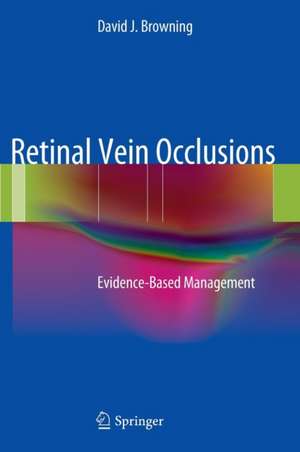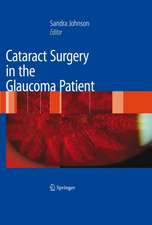Retinal Vein Occlusions: Evidence-Based Management
Autor David J. Browningen Limba Engleză Hardback – 27 mai 2012
Toate formatele și edițiile
| Toate formatele și edițiile | Preț | Express |
|---|---|---|
| Paperback (1) | 1610.32 lei 6-8 săpt. | |
| Springer – 22 aug 2016 | 1610.32 lei 6-8 săpt. | |
| Hardback (1) | 1438.58 lei 6-8 săpt. | |
| Springer – 27 mai 2012 | 1438.58 lei 6-8 săpt. |
Preț: 1438.58 lei
Preț vechi: 1514.30 lei
-5% Nou
Puncte Express: 2158
Preț estimativ în valută:
275.26€ • 287.40$ • 227.82£
275.26€ • 287.40$ • 227.82£
Carte tipărită la comandă
Livrare economică 04-18 aprilie
Preluare comenzi: 021 569.72.76
Specificații
ISBN-13: 9781461434382
ISBN-10: 1461434386
Pagini: 404
Ilustrații: XIII, 387 p.
Dimensiuni: 178 x 254 x 27 mm
Greutate: 1.13 kg
Ediția:2012
Editura: Springer
Colecția Springer
Locul publicării:New York, NY, United States
ISBN-10: 1461434386
Pagini: 404
Ilustrații: XIII, 387 p.
Dimensiuni: 178 x 254 x 27 mm
Greutate: 1.13 kg
Ediția:2012
Editura: Springer
Colecția Springer
Locul publicării:New York, NY, United States
Public țintă
Professional/practitionerDescriere
After diabetic retinopathy, the varieties of retinal vein occlusion (central, hemi-central, and branch) constitute the most prevalent category of retinal vascular disease. For macular edema associated with central retinal vein occlusion (CRVO), no effective therapy existed until 2009 despite decades of research and failed pilot therapies. In 2009, serial intravitreal triamcinolone therapy was proven to be effective compared to observation. In 2010, a randomized controlled trial reported that laser anastomosis was associated with improved vision relative to observation. For iris neovascularization associated with CRVO, laser panretinal photocoagulation has been proven to be effective at reducing neovascular glaucoma since 1995 and intraocular anti-VEGF drug injections for short term regression of iris neovascularization since 2005. For macular edema associated with branch retinal vein occlusion (BRVO), grid laser photocoagulation was proven to have modest benefits compared to observation since 1988. Sector panretinal photocoagulation for retinal neovascularization associated with BRVO was proven to be effective in reducing vitreous hemorrhage in 1990.
Many proposed surgical therapies including radial optic neurotomy, retinal venous sheathotomy, and vitrectomy with panretinal laser photocoagulation have been piloted and abandoned in the last 20 years because of an excess of adverse side effects or lack of efficacy relative to a treatment benefit.
In the past 5 years, intravitreal injections of anti VEGF drugs have been developed and hold out the promise of improved outcomes compared to the older therapies. Concomitant with these treatment advances has been an improved but incomplete understanding of the underlying pathophysiology of retinal vein occlusions.
Cuprins
Table of Contents
1. Anatomy and Pathologic Anatomy of Retinal Vein Occlusions
2. Pathophysiology of Retinal Vein Occlusions
3. Genetics of Retinal Vein Occlusions
4. Classification of Retinal Vein Occlusion
5. Epidemiology of Retinal Vein Occlusions
6. Systemic and Ocular Associations of Retinal Vein Occlusions
7. The Clinical Picture and Natural History of Retinal Vein Occlusions
8. Ancillary Testing in the Management of Retinal Vein Occlusions
9. Ischemia and Retinal Vein Occlusions
10. Posterior Segment Neovascularization in Retinal Vein Occlusion
11. Anterior Segment Neovascularization in Retinal Vein Occlusion
12. Macular Edema in Retinal Vein Occlusion
13. Treatment of Retinal Vein Occlusions
14. Retinal Vein Occlusions in the Young 15. Failed and Unadopted Treatments for Retinal Vein Occlusions
16. Case Studies in Retinal Vein Occlusion
1. Anatomy and Pathologic Anatomy of Retinal Vein Occlusions
2. Pathophysiology of Retinal Vein Occlusions
3. Genetics of Retinal Vein Occlusions
4. Classification of Retinal Vein Occlusion
5. Epidemiology of Retinal Vein Occlusions
6. Systemic and Ocular Associations of Retinal Vein Occlusions
7. The Clinical Picture and Natural History of Retinal Vein Occlusions
8. Ancillary Testing in the Management of Retinal Vein Occlusions
9. Ischemia and Retinal Vein Occlusions
10. Posterior Segment Neovascularization in Retinal Vein Occlusion
11. Anterior Segment Neovascularization in Retinal Vein Occlusion
12. Macular Edema in Retinal Vein Occlusion
13. Treatment of Retinal Vein Occlusions
14. Retinal Vein Occlusions in the Young 15. Failed and Unadopted Treatments for Retinal Vein Occlusions
16. Case Studies in Retinal Vein Occlusion
Notă biografică
Dr. Browning is Retina Specialist at Charlotte Eye Ear Nose and Throat Associates in Charlotte, North Carolina, USA, and is involved with the Diabetic Retinopathy Clinical Research network.
Textul de pe ultima copertă
After diabetic retinopathy, the varieties of retinal vein occlusion constitute the most prevalent category of retinal vascular disease. For macular edema associated with central retinal vein occlusion (CRVO), no effective therapy existed until 2009, despite decades of research and failed pilot therapies. This comprehensive, illustrated text integrates recent advances in treatments with the parallel progress in understanding of disease mechanisms. Complete with case studies, this text is perfect for retina specialists, ophthalmologists, optometrists, and residents and fellows in these fields.
Caracteristici
First comprehensive text on retinal vein occlusions, the second most common kind of retinal vascular disease
Integrates recent advances in treatments with the parallel progress in understanding of disease mechanisms
Includes case studies
Includes supplementary material: sn.pub/extras
Includes supplementary material: sn.pub/extras
Integrates recent advances in treatments with the parallel progress in understanding of disease mechanisms
Includes case studies
Includes supplementary material: sn.pub/extras
Includes supplementary material: sn.pub/extras






